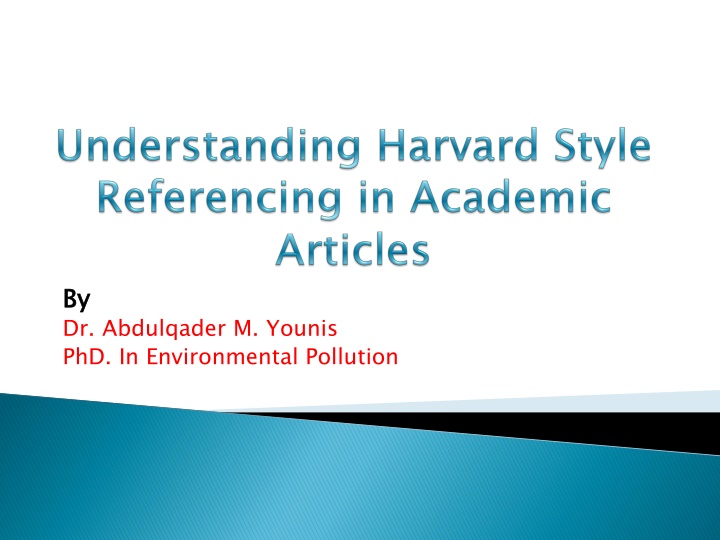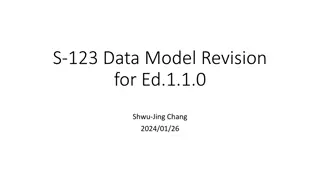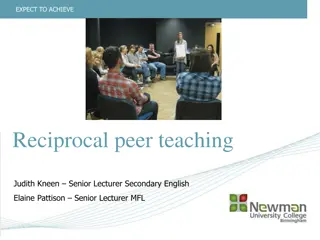
Mastering Harvard Style Referencing for Academic Success
Dive into the world of Harvard style referencing with an emphasis on its importance in academic writing. Learn about citation consistency, in-text citations, and creating detailed reference lists. Explore examples for books and journal articles to enhance your academic credibility and transparency.
Download Presentation

Please find below an Image/Link to download the presentation.
The content on the website is provided AS IS for your information and personal use only. It may not be sold, licensed, or shared on other websites without obtaining consent from the author. If you encounter any issues during the download, it is possible that the publisher has removed the file from their server.
You are allowed to download the files provided on this website for personal or commercial use, subject to the condition that they are used lawfully. All files are the property of their respective owners.
The content on the website is provided AS IS for your information and personal use only. It may not be sold, licensed, or shared on other websites without obtaining consent from the author.
E N D
Presentation Transcript
By Dr. Abdulqader M. Younis PhD. In Environmental Pollution By
INTRODUCTION INTRODUCTION We explore the complex realm of academic reference today, with a special emphasis on the referencing is essential for building credibility and providing credit where credit is due, regardless of experience level in research or student status. The fundamentals and rules of Harvard style referencing, its importance in academic successfully implementing it into your papers will all be covered in this lecture. Harvard style. Learning the art of writing, and helpful hints for
Understanding Harvard Style Referencing: a. citation consistency, acknowledging sources. b. referencing citations (author's last name and year of publication) within the body of the text. Harvard referencing style is a widely-used clarity, that and emphasizes accessibility in Unlike other incorporates citation styles, brief Harvard in-text
Understanding Harvard Style Referencing: c. A detailed reference list is then provided at the end of the document, listing all sources cited in the text alphabetically by author's last name. d. easily locate and verify the sources used by the academic integrity. Harvard referencing allows readers to author, promoting transparency and
a. Books: Author(s) last name, initial(s). (Year). Title. Edition (if applicable). Place of publication: Publisher. In-text citation structure and example: (Author Surname, Publication Year) (Ozeki, 2013) Reference example: Ozeki, R. (2013) A tale for the time being. New York: Penguin Books. (Bloom, 2005) Bloom, H. (2005) Novelists and novels. Philadelphia: Chelsea House Publishers. b. Journal Articles: Author(s) last name, initial(s). (Year). Article number), page range. title. Journal Name, volume number(issue
Book with two or three authors For books with two or three authors, the names of all the authors are given in both the in-text citation and the reference entry. In-text citation structure and example: (1st Publication Year) (Lodge and Wood, 2000) Reference structure and example: 1st Surname, Initials. (Publication Year) Title of the text in italics. Place of Publication: Publisher. Lodge, D. and Wood, N. (2000) Modern criticism and theory: a reader. 2nd edn. Harlow: Longman. Author Surname and 2nd Author Surname, Author Surname, Initials. and 2nd Author
Book with four or more authors If the number of authors is four or more, only the first author s name is used followed by et al. , italicised, which is Latin for and others . In-text citation structure and example: (1stAuthor Surname et al., Publication Year) (Akmajian et al., 2014) Reference structure and example: 1stAuthor Surname, Initials. et al. (Publication Year) Title of the text in italics. Place of Publication: Publisher. Akmajian, introduction to language and communication. 6th edn. Cambridge, MA: MIT Press. A. et al. (2014) Linguistics: an
Book with translator For books with a translator, only the author s name is included in the in-text reference. given in the reference list entry, along with the language from which it was translated. This comes right after the title. In-text citation structure and example: (Author Surname, Publication Year) (Dostoevsky, 1993) Reference structure and example: Author Surname, Initials. (Publication Year) Title of the text Translator Publisher. Dostoevsky, Translated from the Russian by R. Pevear and L. Volokhonsky. London: Vintage. The translator is in italics. Initials. Translated Surname. from the Language of by Place Publication: F. (1993) Crime and punishment.
Journal articles are highly credible sources of information. The example below was authored by more than three individuals, so the term et al. is used in lieu of listing all authors. In-text citation structure and example: (Author Surname, Publication Year) (Lomolino et al., 2020) Journal reference list entries often have extra information, such as article title, volume, issue number, page numbers, or a specific date. With journals, the volume number follows the title. If there are any specific parts of the issue, numbered or organized according to months, these details are mentioned alongside in brackets. Reference structure and example: Author Surname, Initials. (Publication Year) Article title , Journal Name, Volume(Issue), Page(s). Available at: URL or DOI (Accessed: date). Lomolino, M. et al. (2013) Of mice and mammoths: generality and antiquity of the island rule , Journal of Biogeography, 40(8), pp. 1427-1439. Available at: 2020). https://www.jstor/org/stable/23463664 (Accessed: 10 September
KA. Hawrami, NM. Crout, G. Shaw, and EH. Bailey.(2020) toxic elements in vegetables cultivated in urban and peri-urban sites in the Kurdistan region of Iraq and implications for human health Health, doi:10.1007/s10653-019-00426-z. Assessment of potentially Environmental Geochemistry and 42(5): 1359 1385,
In-text citation structure and example: (Author Surname, Publication Year) (Ingle, 2020) Reference structure and example: Author title , Newspaper/Magazine Name, Day Month Published, Page(s). Available at: URL or DOI (Accessed: date). Ingle, S. (2020) Geraint Thomas insists he has nothing to prove at road world championships , The Guardian, 24 September. https://www.theguardian.com/sprot/2020/sep/24/geraint- thomas-insists-he-has-nothing-to-prove-at-road-world- championships-cycling (Accessed: 11 October 2020). For online articles, you should always include the URL and date of access. Surname, Initials. (Publication Year) Article Available at:
References for social media posts have a similar format to online articles. However, sometimes they don t have a true title . For example, for Twitter posts, the full text of the tweet is used as the title, unless the tweet is overly long. Author/Poster Surname, Initial(s). [@Handle] (Publication year) Content of Post [Social Media Site] Day Month Published. Available at: URL (Accessed: Day Month Year). Cramer, K. [@SenKevinCramer] (2020) Supreme Court vacancies are an important issue to the people I serve [Twitter] 24 September. Available at: https://twitter.com/SenKevinCramer/status/1308915548244 398081 (Accessed: 25 September 2020). The format for citing social media is different than the format for citing regular websites and web pages. This guide on how to cite a website in Harvard style provides details on how to cite web content that is not posted on social media.
a. Demonstrates intellectual contributions of others. b. Allows readers to trace and verify the sources used in the text, enhancing credibility and transparency. c. Facilitates the dissemination of knowledge by providing a standardized format for referencing across disciplines. : . . academic integrity by acknowledging the . . . . : . . . . . .
In referencing is essential for any academic writer striving to uphold the highest standards of scholarly communication. By adhering to the principles of clarity, consistency, and accuracy, you contributions credibility and reliability of your own work. Embrace Harvard style referencing as a tool for fostering academic integrity and advancing the collective pursuit of knowledge. conclusion, mastering Harvard style can effectively of acknowledge while the the others enhancing






















